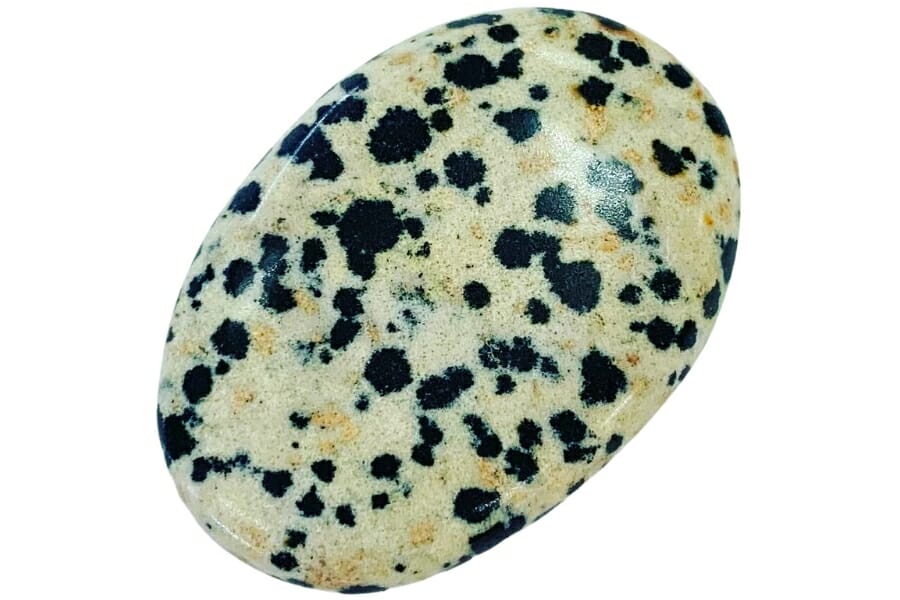Picture a stone that mimics a Dalmatian dog’s playful coat— that is the fascinating Dalmatian stone, and it’s every bit as intriguing as it sounds!
If you’ve ever seen them in a rock shop or glimpsed them in the wild, you’ll immediately recognize Dalmatian stones for their peculiar appearance. But how would you know if you’re looking at a genuine one? We’re here to teach you that.
We’ll also dive deep into the mysteries of how such unique-looking stones came to be. Lastly, we’ll discuss if there is more to these stones than their looks and if they are precious or merely delightful novelties.
So, pull on your explorer’s hat and grab your magnifying glass as we embark on a thrilling journey to uncover the wonders of Dalmatian stones. Let’s rock and roll!
What Dalmatian Stones Are
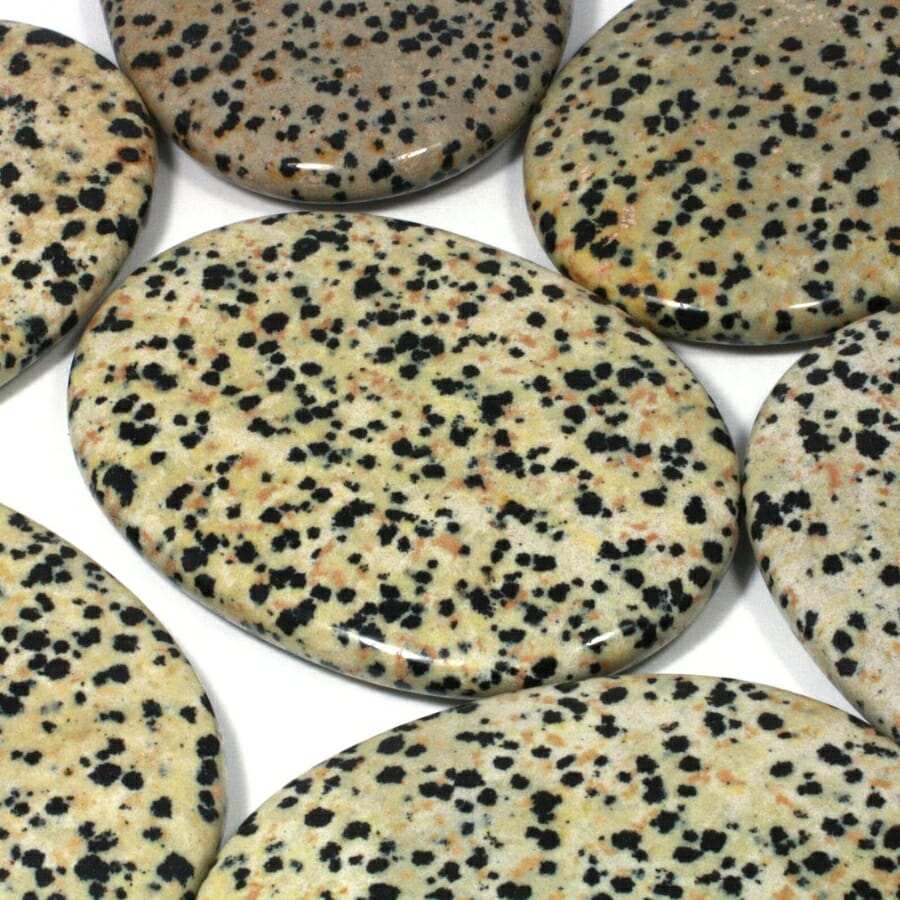
Dalmatian stone, sometimes called “Dalmatian jasper“, is a distinctive rock that catches the eye because of its unique look. It has a creamy white base sprinkled with black and sometimes brown or rust-colored spots.
Its spots are primarily made of black tourmaline, a mineral known for its rich dark color. The white background of the stone is mainly composed of feldspar, which gives it its creamy, sometimes slightly shiny, texture.
While it’s called “Dalmatian jasper”, it isn’t genuine jasper. Dalmatian stone’s composition sets it apart from jaspers. However, this name has stuck around due to its popularity among jewelry makers and collectors.
How Dalmatian stones got their name
Dalmatian stones bear a striking resemblance to something many of us are familiar with: the Dalmatian dog breed.
You’ve probably seen these dogs in movies or cartoons, characterized by their short white fur decorated with black spots. The stone was fondly named after the dog, which makes it easier to remember and quite fun to talk about!
Its name helps paint a vivid image in our minds even before we see the stone. Imagine telling someone about a white stone with black speckles. They might picture something entirely different.
But when you say “Dalmatian stone,” the mental image becomes clear right away, thanks to our familiarity with the Dalmatian dog.
Are Dalmatian Stones natural
With its unusually striking look, it’s easy to mistake Dalmatian stones for being synthetically produced. But this beauty is a naturally occurring rock! It’s a product of processes that transpired over countless years.
However, like many other rocks and minerals, it’s possible to create synthetic versions of Dalmatian stones in a laboratory setting. Through advanced technology, scientists can reproduce its mineral compositions and structural patterns.
What’s special about Dalmatian Stones
First off, Dalmatian stones’ unique appearance sets them apart. Just think about it: how many stones can you name that reminds you of a playful dog breed?
Beyond their looks, these stones are said to have positive vibes and energy. It’s often associated with playfulness, loyalty, and a sense of fun— just like the Dalmatian dogs themselves!
How Dalmatian Stones Form
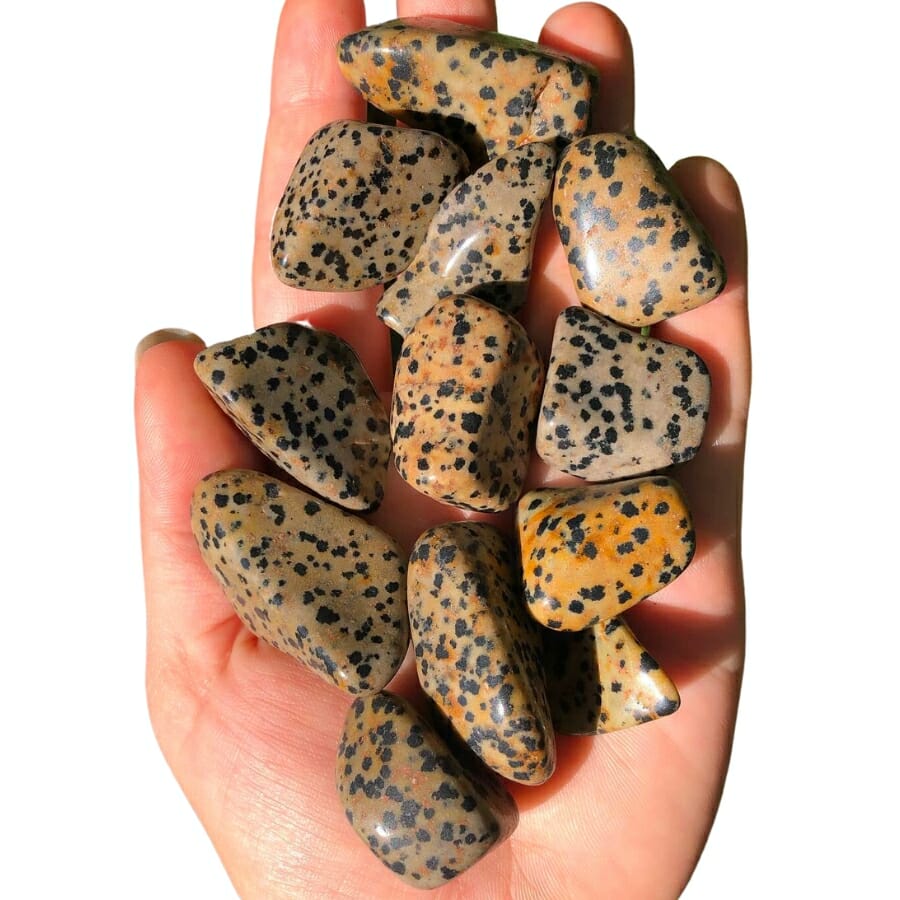
The primary ingredient in a Dalmatian stone is a mineral called feldspar. It’s quite common and can be found in many rocks around the world. It’s what gives the stone its creamy white color.
Now, for the spots! Those characteristic black and sometimes brown or rust-colored speckles are mainly due to another mineral, known as black tourmaline.
As the Earth’s tectonic plates move and shift, heat and pressure are created in the deeper layers. This heat causes different minerals to melt and become a sort of liquid soup. Over time, as this mixture cools down and solidifies, various minerals start to come together.
In the case of the Dalmatian stone, feldspar and black tourmaline, among others, unite to form its unique appearance.
What Dalmatian Stones Look Like
While we’ve given a general overview of what Dalmatian stones look like (clue: just look at a Dalmatian dog’s fur!), it pays to know how differently they’d appear if they were in their raw condition and in their cut or polished look.
Raw Dalmatian Stone
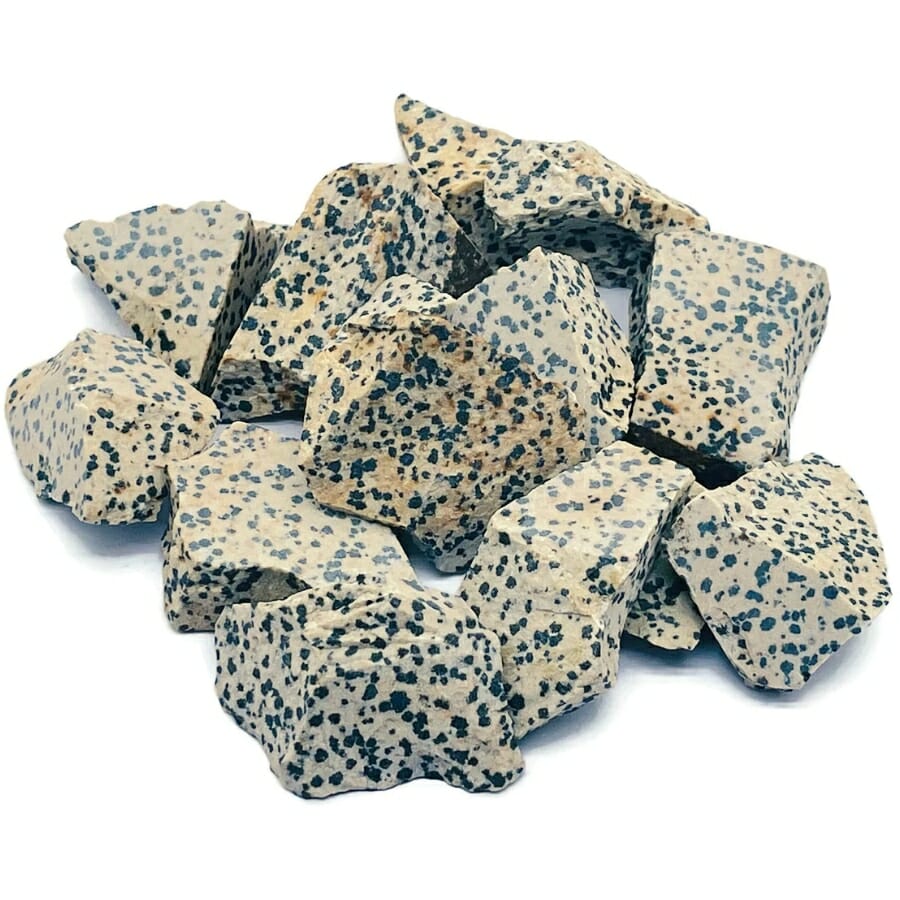
When you first come across a rough Dalmatian stone, you might think it looks like any other ordinary rock. But upon closer inspection, its special features start to shine through.
The surface of a raw Dalmatian stone won’t be shiny. Instead, it will have a matte finish, feeling a bit rough to the touch. You might also notice tiny crevices, bumps, or other natural markings on the stone.
Its base color is usually a creamy white or off-white. Its characteristic speckles of black and sometimes brown or rust color can vary in size and distribution. Some might have a dense pattern of spots, while others may have them spaced out. The spots can be small like tiny dots or slightly larger, similar to the size of a peppercorn.
Cut or polished Dalmatian Stone
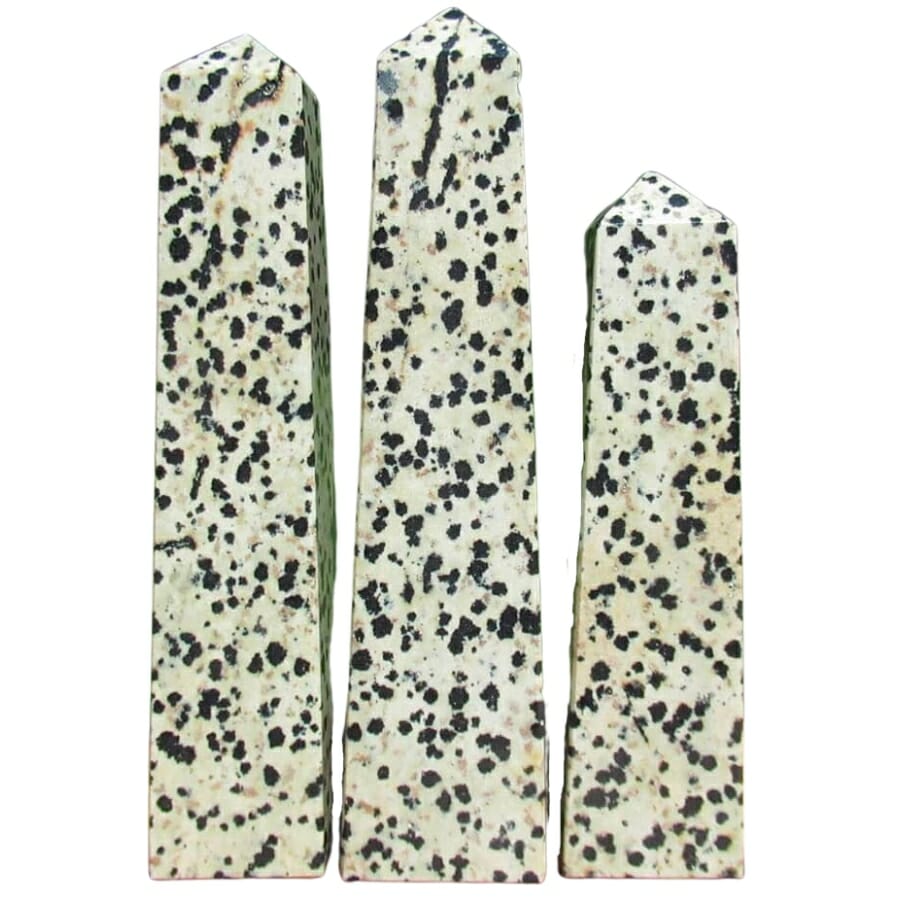
Cut or polished Dalmatian stones are like the upgraded versions of their rough counterparts. When they undergo the process of cutting and polishing, their true beauty really comes to the forefront. The transformation can be pretty amazing!
The base color of a polished Dalmatian stone remains a creamy white, but the shine and smoothness give it a more refined look. The black, brown, or rust-colored speckles stand out even more against the polished background.
Its clarity is enhanced, too, making the contrast between the creamy white and the speckles even more noticeable. Because it’s been polished, this stone will have a glossy finish, capturing light and making it sparkle.
When cut and shaped, these stones can take on various forms, like rounded pebbles, oval cabochons, or even intricate shapes for jewelry.
Where You Can Find Dalmatian Stone
Dalmatian stone is found in several locations worldwide, often where the conditions favor the formation of its distinctive mineral composition.
While it does not naturally occur in the United States, you can find many rocks and minerals that are just as beautiful and interesting. Check out our guide to the best rockhounding locations to find them.
You can also refer to our guide to finding gems near you to spot equally captivating gemstones.
Always Confirm Access and Collection Rules!
Before heading out to any of the locations on our list you need to confirm access requirements and collection rules for both public and private locations directly with the location. We haven’t personally verified every location and the access requirements and collection rules often change without notice.
Many of the locations we mention will not allow collecting but are still great places for those who love to find beautiful rocks and minerals in the wild without keeping them. We also can’t guarantee you will find anything in these locations since they are constantly changing.
Always get updated information directly from the source ahead of time to ensure responsible rockhounding. If you want even more current options it’s always a good idea to contact local rock and mineral clubs and groups
Mexico
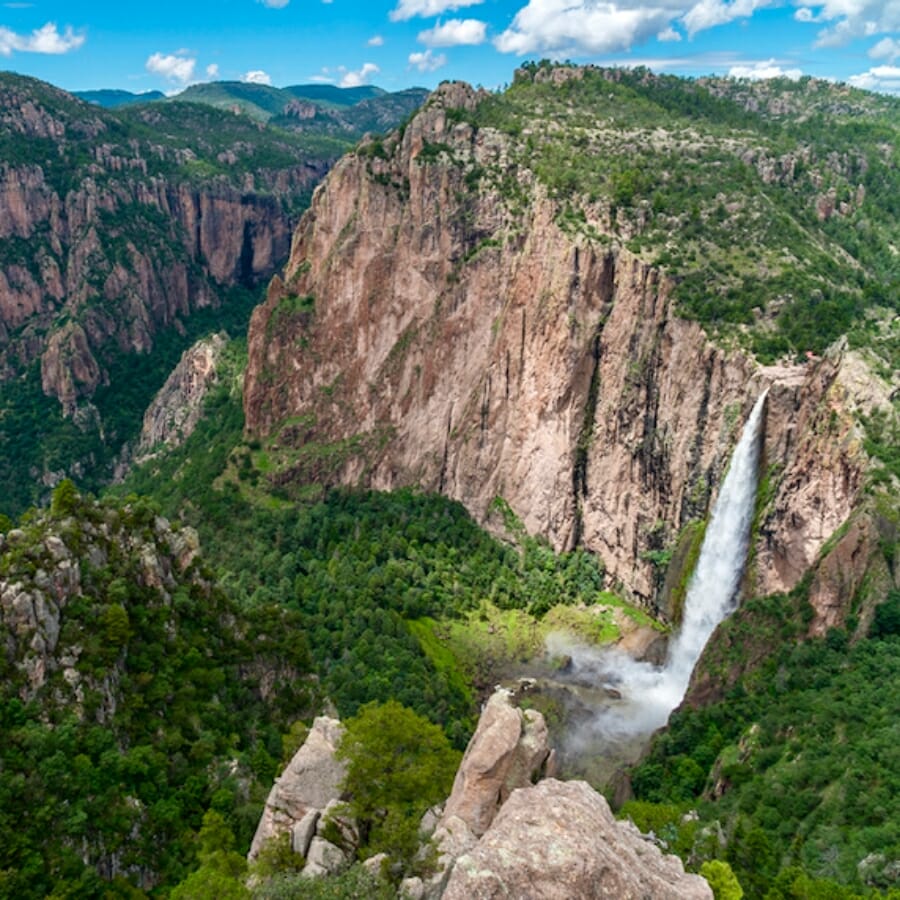
Mexico is a geologist’s dream! It’s a part of a region known as the Ring of Fire, a huge area in the Pacific Ocean where a lot of earthquakes and volcanic eruptions happen because of the tectonic plates’ movements.
Over millions of years, all the heat and pressure from these activities have pushed up minerals, forming rich deposits. That’s how we get so many unique and beautiful stones in Mexico.
Its rock formations, ranging from ancient limestone caves to volcanic terrains, allow for a wide array of minerals and gemstones to form.
Thanks to its location on the Ring of Fire, its diverse landscapes, and its rich mix of minerals, Dalmatian stones are one of the treasures you can find in Mexico.
Where you can find Dalmatian stone in Mexico
Dalmatian stones are primarily sourced from the northern region of Mexico, particularly in the state of Chihuahua. It has vast mineral deposits and is known for its rich mining history.
South Africa

South Africa is like a storybook of the past, told through its rocks and landscapes. One of its most famous geologic features is the Great Escarpment, a series of cliffs and plateaus that stretch around the country.
But that’s just the start of what makes South Africa’s geology so exciting.
This land has been shaped by a series of ancient volcanic eruptions and tectonic movements that have brought a wealth of minerals up from deep within the Earth. This is why South Africa is known for its mineral riches, from gold and diamonds to more unusual stones.
With its unique mix of rock formations and mineral-rich soils, South Africa offers the right conditions for Dalmatian stones to form.
Where you can find Dalmatian stone in South Africa
Dalmatian stones can be found in the mining regions of South Africa. The country’s long history of mining and gemstone trade makes it a notable source of this semi-precious stone.
China

China, vast and diverse, stretches from snowy mountain peaks to vast plains and dense forests. Its geology is as varied as its landscapes!
This variety in landscapes means a lot of different rocks and minerals. Over millions of years, China’s lands have been shaped by tectonic plate movements, volcanic eruptions, and the power of wind and water. These natural processes have pushed up tons of treasures, including different gemstones and minerals.
China’s rich geology, especially in areas with past volcanic activity, provides the perfect setting for feldspar and tourmaline to mix. This makes some regions of this country ideal for finding Dalmatian stones.
In fact, China is one of the global suppliers of Dalmatian stones, exporting them to various parts of the world.
Where you can find Dalmatian stone in China
Dalmatian stones are found in the northeastern provinces of China. One of the most notable regions for its production is Heilongjiang Province.
How To Find Dalmatian Stone
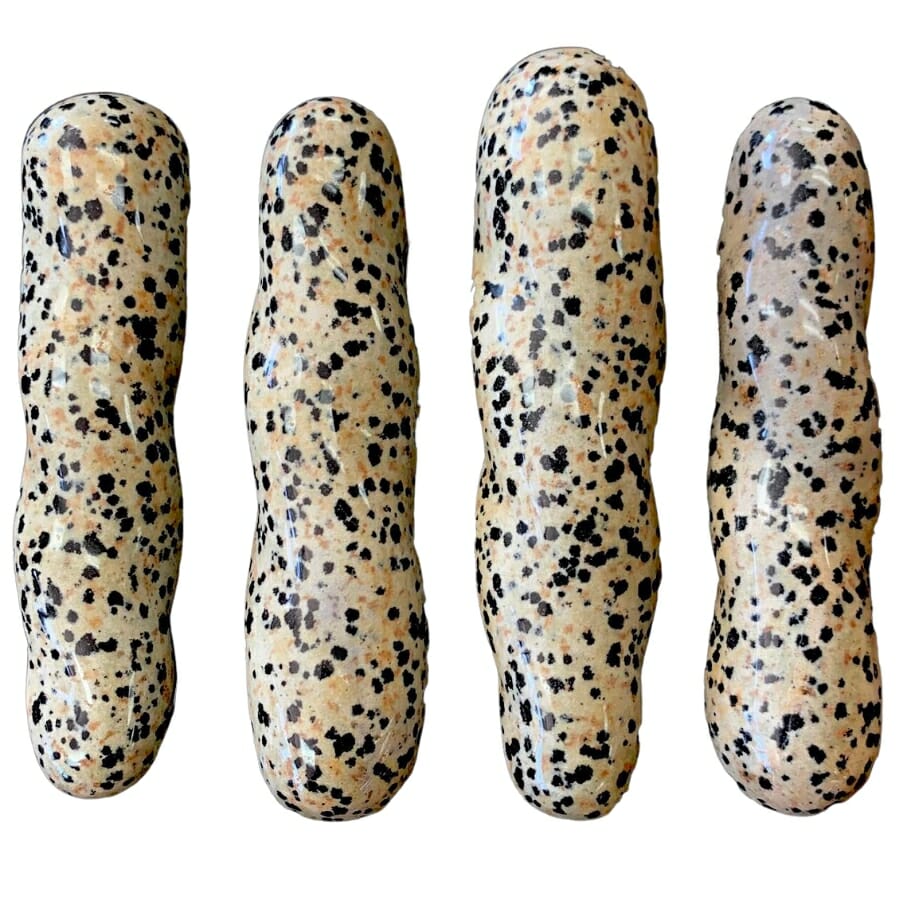
In your search for Dalmatian stone, different rockhounding tools will prove to be very useful. It would also help a lot if make sure to pay close attention to the following areas where these stones are usually hiding and waiting to be uncovered:
Quarries
Quarries are like giant treasure troves for rock lovers, and they are particularly great spots for finding Dalmatian stones. This is because layers and layers of rock that aren’t visible on the surface are exposed in quarries due to constant digging.
When machines or workers remove massive amounts of stone and soil, they often uncover hidden pockets of minerals and gems. This means that a rock like the Dalmatian stones can suddenly become accessible.
Quarries also often contain a specific type of rock or mineral. If it’s situated in an area known for its igneous rocks, the chances of finding Dalmatian stones there can be higher.
Mine and Mine Dumps
Mines dive deep, reaching places that many of us would never see otherwise. As miners dig, they often come across pockets of minerals and gems that have been hidden away for ages.
This makes mines a great place to find rare and unique stones, including the Dalmatian stone.
Meanwhile, mine dumps are piles of rock and dirt that get removed during mining. It might seem like a pile of waste at first glance, but you can actually sift through these piles to find Dalmatian stones.
Sediment Deposits
Sediment deposits are formed when tiny particles, like dirt, sand, and even small rocks, get carried away by water or wind and settle in a new spot. Over time, these layers build up and hide incredible treasures, including Dalmatian stone.
These deposits act like natural sorters. When natural forces break down rocks and minerals, the heavier pieces often settle first. Over time, these get buried by layers and layers of sediment. This process can protect gems from the elements and keep them in pretty good condition.
What’s even better is that sediment deposits can be found in many places, from river banks and streams to the bottoms of lakes and oceans.
How To Identify Dalmatian Stone
If you’re planning on searching for Dalmatian stone, it’s important to know how to identify it from the inside out. We’ll give you a few pointers that will help you successfully pick out this stone from a pile of other rocks and minerals.
Identification from the outside
From the outside, a Dalmatian stone has the following characteristics:
A striking color pattern like that of a Dalmatian dog breed
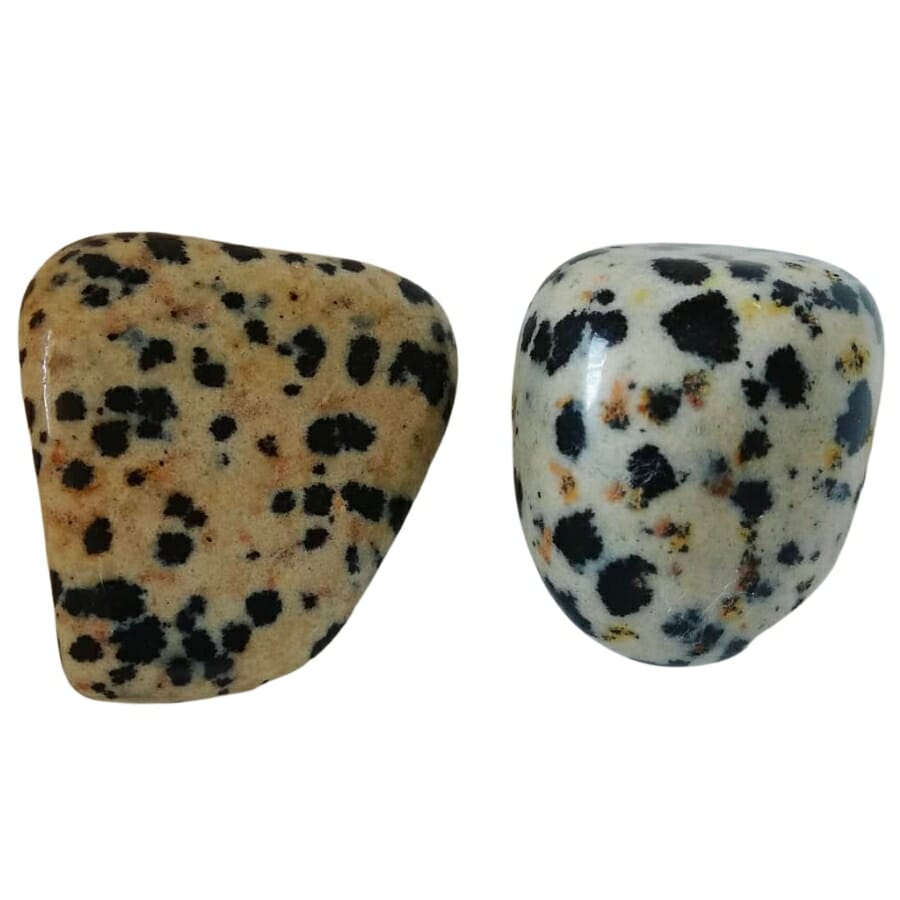
This stone has a creamy white to light beige background, which serves as a canvas for a scattering of black, brown, or rust-colored speckles. These spots are what give the stone its name.
No two stones will have the exact same pattern, but that mix of light base and dark spots is a significant identifier.
Rough but quite soft surface
When you pick up a Dalmatian stone, it’ll feel rough if it’s unpolished. It isn’t overly hard, so it can be easily scratched with a steel nail. This is different from some other stones that might look similar but have a much harder surface.
Irregular shape
Dalmatian stones found in nature are usually irregular in shape. They aren’t typically perfectly round or square unless they’ve been shaped by a person. Instead, they’ll have a more random, natural form.
This irregularity can help you identify them when mixed with other pebbles or stones.
Identification from the inside
When you cut a rock that you suspect is a Dalmation stone, there are a few other tips that will help you confirm your guess, such as:
Consistent patterns
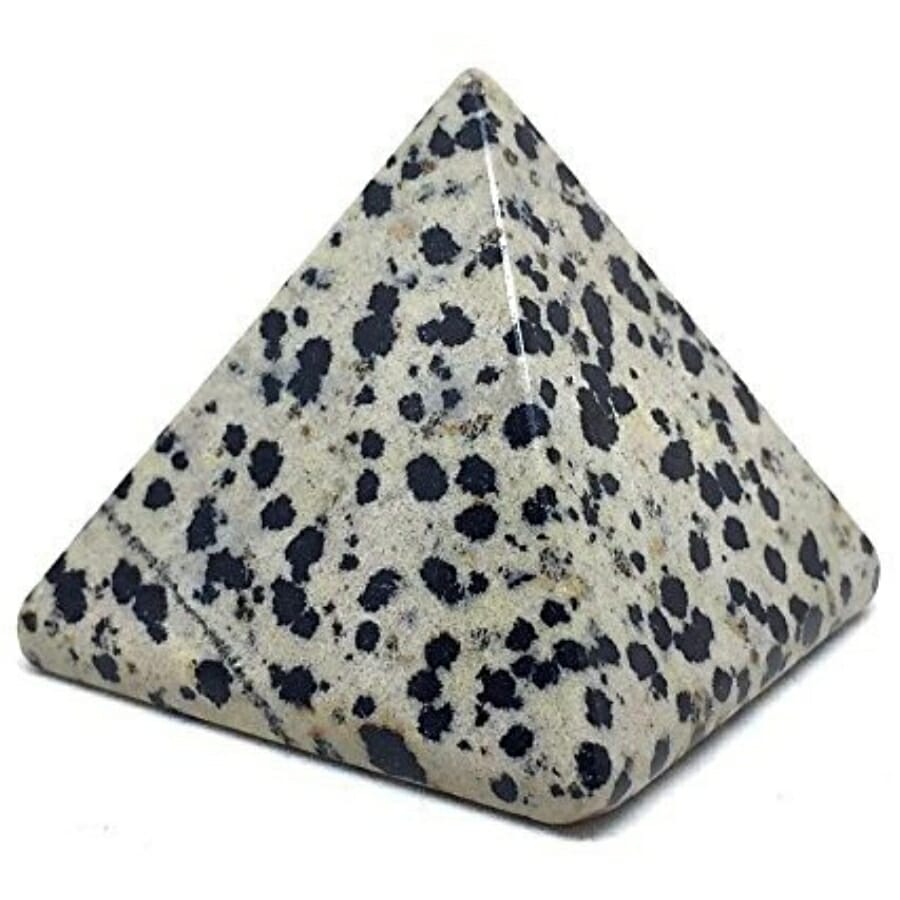
From the outside, you see the speckled pattern of a Dalmatian stone. But when it’s cut open, this pattern remains consistent throughout the inside, too. Those signature spots aren’t just surface deep; they go all the way through.
No air bubbles
If you look closely at the inside of a genuine Dalmatian stone, you shouldn’t find any air bubbles. Some synthetic stones or imitations might have these bubbles, but natural Dalmatian stones won’t.
The presence of air bubbles might suggest it’s man-made or an imitation.
Grainy texture
This grainy texture is because of the way the minerals have formed and settled over time.
When you observe this in a suspected Dalmatian stone, it’s also a good hint that you’re dealing with a natural stone and not something that’s been artificially created.
Identifying Dalmatian Stone Using Geological Properties
Now that you know all about Dalmatian stone, including its formation process, where it can be found, and how you can identify it from inside and out, we’ll go into the more scientific approach to getting to know this stone: its geological properties.
| Chemical Composition | Feldspar, Tourmaline |
| Color | Creamy white to beige with black, brown, or rust-colored speckles |
| Hardness | 6 to 6.5 on the Mohs scale |
| Density | Approximately 2.8 to 2.9 g/cm³ |
| Refractive Index | Approximately 1.54 to 1.55 |
| Crystal Form | No specific crystal form |
| Luster | Vitreous |
The Uses Of Dalmatian Stone
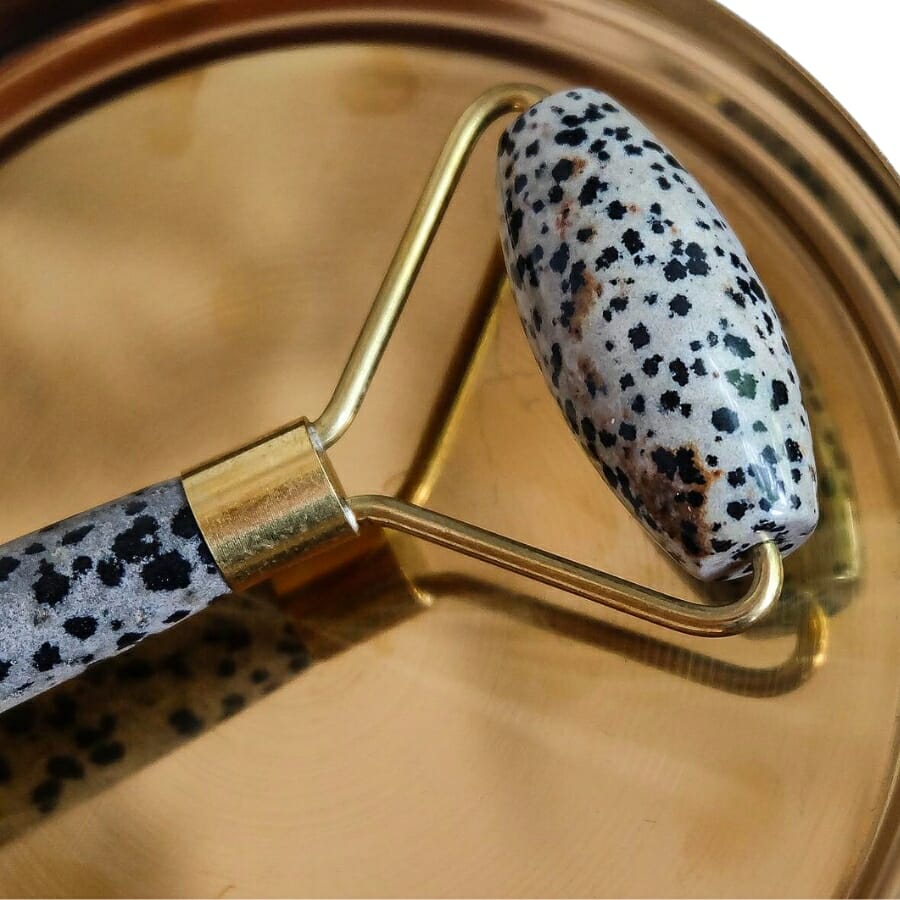
Dalmatian stones have found their way into various uses. These stones are often cut, polished, and turned into beautiful jewelry. Their neutral colors, combined with the playful black and brown speckles, make them versatile and desirable.
Another fun use for Dalmatian stones is in home decor. Imagine having a lovely bowl filled with these speckled stones on your coffee table. They can add a touch of natural beauty to any room.
And because of their cool and calming colors, they’re often used in settings like spas or massage therapy rooms to help set a relaxing mood.
Some people also believe that Dalmatian stones have healing properties. Though not scientifically proven, it’s said to help clear negative thoughts and energy.
Lastly, Dalmatian stones are great for educational purposes. Their unique composition offers an interesting study of mineral combinations and how different minerals can come together to form a single, beautiful stone.
How Much A Dalmatian Stone Is Worth

When it comes to Dalmatian stone’s value, they’re reasonably accessible to most enthusiasts.
In general, stones that are cut into simple shapes, like basic ovals or rectangles, are often priced at $7 or less per carat. This affordability makes them a popular choice for those just starting out in their gemstone collection or those looking for unique but not overly expensive jewelry pieces.
However, Dalmatian stone’s value can change when it comes in intricate designs. Stones that are cut and polished by skilled artisans into unique designer shapes or forms fetch a different price.
Surprisingly, these fine-quality stones with designer cuts can range between $1 to $10 per carat. The price variation within this range depends on the quality, size, and uniqueness of the stone.
Dalmatian stone’s relative affordability, combined with its eye-catching appearance, makes it a favorite among those who appreciate nature’s beauty without breaking the bank.

